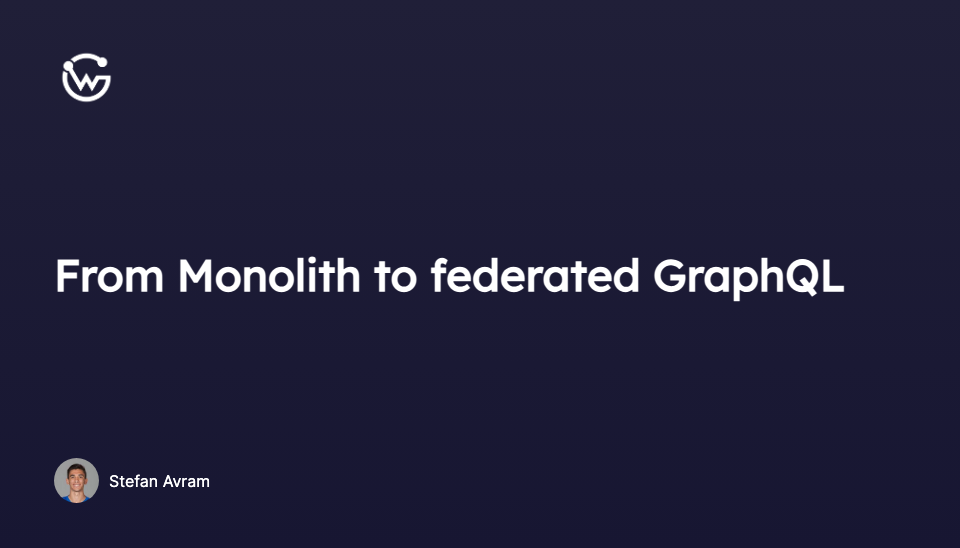Transitioning from Monolithic to Federated Architecture with GraphQL


Stefan Avram
In the ever-evolving landscape of software development, the architectural patterns we choose to implement can significantly impact our applications' scalability, maintainability, and overall efficiency. While monolithic architectures have been the bedrock of many systems, the dynamic nature of modern application demands has led to a paradigm shift towards more modular and flexible structures. Among these, the transition to Federated architecture, particularly with an emphasis on GraphQL, is gaining traction and offering a promising solution to the limitations of traditional monolithic systems.
Introducing WunderGraph Hub: Rethinking How Teams Build APIs
WunderGraph Hub is our new collaborative platform for designing, evolving, and shipping APIs together. It’s a design-first workspace that brings schema design, mocks, and workflows into one place.
Monolithic architectures, characterized by a single, unified codebase, have been the traditional approach to building applications. However, as applications grow in complexity and scale, this architecture often becomes cumbersome to manage. The tightly coupled nature of components in a monolithic system can lead to challenges in scalability, flexibility, and speed of development.
Federated architecture, in contrast, is a decentralized model that breaks away from monolithic systems, creating an interconnected network where each participant - whether a system, application, or database - maintains a level of autonomy. This architecture's modularity allows for more agile development, easier scaling, and improved fault tolerance.
Incorporating GraphQL into this federated model enhances these benefits further. GraphQL is a query language for APIs that enables requesting only the data needed, making applications more efficient and developer-friendly. Federated GraphQL extends this by dividing the GraphQL schema into smaller, interconnected subgraphs, each manageable and developable independently. This approach fosters greater modularity and flexibility, addressing the scalability and maintainability challenges inherent in monolithic systems.
In a Federated GraphQL system, the schema is divided into smaller, self-contained subgraphs. This division means that developers can work more independently, iterating faster on separate subgraphs without dependencies on the entire system. This modularity not only speeds up development but also simplifies maintenance.
Federated GraphQL offers seamless scalability. New subgraphs or services can be added as needed without disturbing the existing structure. This flexibility is crucial in modern applications, where adaptability to changing requirements is essential.
By loading only necessary subgraphs, Federated GraphQL optimizes performance and minimizes data over-fetching. This efficiency is a significant departure from monolithic applications, where over-fetching data can lead to inefficiencies.
Several leading companies, including tech giants and e-commerce platforms, have adopted Federated GraphQL. These organizations have leveraged its scalability and maintainability benefits, highlighting its suitability for high-traffic, complex applications.
Federated GraphQL aligns well with the microservices architecture, making it easier to incorporate microservices into systems. This integration is particularly beneficial in complex applications where different microservices need to work seamlessly together.
Migrating to Federated GraphQL, while beneficial, can be complex. It requires thorough planning and possibly expert guidance. The migration often involves restructuring existing systems and training development teams to adapt to new workflows.
The migration process can initially be daunting, requiring adjustments and a learning curve for development teams. It's essential to consider these challenges and prepare for them adequately.
Federated GraphQL is not just for large-scale applications; it is also adaptable for smaller projects. Its flexibility allows tailoring the level of granularity to suit different project needs.
As more organizations embrace the advantages of Federated GraphQL, its popularity in the development community continues to grow. This trend indicates a positive outlook for its future adoption.
The transition from a monolithic architecture to a Federated one, especially with GraphQL, marks a significant shift in how we approach software architecture. This change is not just about adopting a new technology but about embracing a new philosophy of building scalable, maintainable, and efficient applications. As the development community continues to recognize the benefits of this transition, Federated GraphQL stands out as a compelling choice for modern application architecture.
Stefan Avram
CCO & Co-Founder at WunderGraph
Stefan Avram is the CCO and one of the co-founders of WunderGraph, helping enterprise customers adopt and scale federated architecture. A former software engineer, he translates technical value into practical outcomes and shaped WunderGraph's early customer motion, guiding platform teams from onboarding to production in demanding environments. A former college soccer player, he brings a competitive, team-driven mindset to every stage of customer growth, with a focus on helping engineering-led organizations move fast without losing control.

